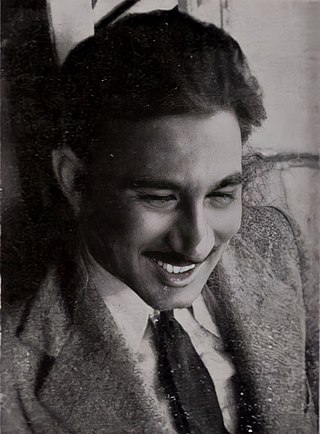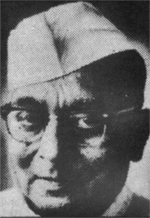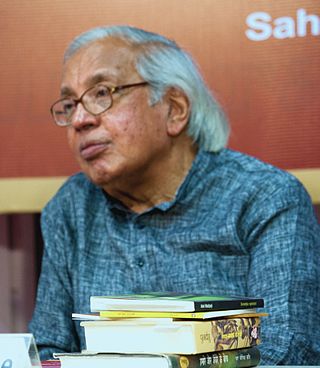Related Research Articles

Khwaja Ahmad Abbas was an Indian film director, screenwriter, novelist, and journalist in Urdu, Hindi and English.

Bhagwati Charan Verma was a Hindi author. He wrote many novels, his best work was Chitralekha (1934), which was made into two successful Hindi films in 1941 and 1964 respectively. He was awarded Sahitya Akademi Award for his epic five-part novel, Bhoole Bisre Chitra in 1961 and Padma Bhushan in 1971. He was also nominated to Rajya Sabha in 1978.

Ram Sharan Sharma was an Indian historian and Indologist who specialised in the history of Ancient and early Medieval India. He taught at Patna University and Delhi University (1973–85) and was visiting faculty at University of Toronto (1965–1966). He also was a senior fellow at the School of Oriental and African Studies, University of London. He was a University Grants Commission National Fellow (1958–81) and the president of Indian History Congress in 1975. It was during his tenure as the dean of Delhi University's History Department that major expansion of the department took place in the 1970s. The creation of most of the positions in the department were the results of his efforts. He was the founding Chairman of the Indian Council of Historical Research (ICHR) and a historian of international repute.

Amritlal Nagar was one of the prominent Hindi writers of the twentieth century.

Gajanan Madhav Muktibodh was one of the most prominent Hindi poets, essayists, literary and political critics, and fiction writers of the 20th century.

Syed Asghar Wajahat, popularly known as Asghar Wajahat, is a Hindi scholar, fiction writer, novelist, playwright, an independent documentary filmmaker and a television scriptwriter, who is most known for his work, 'Saat Aasmaan' and his acclaimed play, 'Jis Lahore Nai Dekhya, O Jamyai Nai', based on the story of an old Punjabi Hindu woman who gets left behind in Lahore, after the Partition of India, and then refuses to leave.
Chitralekha is a 1934 Hindi novel by the Indian writer Bhagwati Charan Verma about the philosophy of life, love, sin and virtue. The author was still practicing law at Hamirpur when he wrote the novel, which brought him immediate fame and started his literary career.
Chandradhar Sharma Guleri was a writer and scholar of Hindi, Sanskrit, Prakrit and Pali from Jaipur, India. He was born in Jaipur and his father belongs to Guler village in Himachal Pradesh hence "Guleri" at the end of the name. Described as a versatile genius, he is known as the author of Usne Kaha Tha, first published in 1915, which is debated to be the first short story in Hindi. He is also remembered for his efforts to preserve the Jantar Mantar Observatory in Jaipur.
Surya Prakash Chaturvedi is a Cricket critic, writer and historian. He is a former professor of English at the Government Arts and Commerce College, Indore, where he taught for 35 years. He played cricket at the collegiate level, representing Indore University and Christian College, Indore as a middle order batsman. So far he has authored 13 books on the subject, all in Hindi.

Ram Dayal Munda, known as R. D. Munda, was an Indian scholar and regional music exponent. He was awarded the Padma Shri of the year 2010 for his contribution to the field of art.

Ashok Vajpeyi is an Indian Hindi-language poet, essayist, literary-cultural critic, apart from being a noted cultural and arts administrator, and a former civil servant. He was chairman, Lalit Kala Akademi India's National Academy of Arts, Ministry of Culture, Govt of India, 2008–2011. He has published over 23 books of poetry, criticism and art, and was awarded the Sahitya Akademi Award given by Sahitya Akademi, India's National Academy of Letters, in 1994 for his poetry collection, Kahin Nahin Wahin. His notable poetry collections include, Shaher Ab Bhi Sambhavana Hai (1966), Tatpurush (1986), Bahuri Akela (1992), Ibarat Se Giri Matrayen, Ummeed ka Doosra Naam (2004) and Vivaksha (2006), besides this he has also published works on literary and art criticism: Filhal, Kuchh Poorvagrah, Samay se Bahar, Kavita ka Galp and Sidhiyan Shuru ho Gayi Hain. He is generally seen as part of the old Delhi-centric literary-cultural establishment consisting of bureaucrat-poets and academicians like Sitakanta Mahapatra, Keki Daruwalla, J.P.Das, Gopi Chand Narang, Indra Nath Choudhari and K.Satchidanandan.
Śrīrāghavakṛpābhāṣyam is a series of Sanskrit commentaries on the Prasthanatrayi, authored by Rambhadracharya. These commentaries were released on 10 April 1998 by the then Prime Minister of India, Atal Bihari Vajpayee. Rambhadracharya composed a commentary on Narada Bhakti Sutra in 1991, and thus revived the tradition of Sanskrit commentaries on the Prasthanatrayi after five hundred years. This was also the second commentary of the Ramananda Sampradaya on Prasthanatrayi, the first being the Ānandabhāṣyam, composed by Ramananda himself. These commentaries were published by Shri Tulsi Peeth Seva Nyas. The author won the Rajshekhar Samman from the Madhya Pradesh Sanskrit Academy, Bhopal, for the commentaries.

Pandit Niraj Jain was a scholar of Jainism, archaeologist, poet and speaker. His contributions to Jain studies span nearly 60 years. He was also an expert on Urdu poetry, which is unusual for a Jain scholar. He was associated with several organisations. He also lectured on the Ramayana He was a proponent of preserving historical nature of ancient temples. He had travelled and lectured widely in India and overseas .

Madhur Kapila was an Indian novelist, journalist, art critic and a reviewer of Hindi literature. Some of her published works included Bhatke Raahi, Satwan Swar and Saamne ka Aasman. She was a recipient of the Chandigarh Sahitya Akademi Award for lifetime contributions to literature and the Cultural Representative Award from the Punjab Sangeet Natak Akademi.
Ramesh Chandra Shah is an Indian poet, novelist, critic and the author of Sahitya Academy Award winning novel, Vinayak. He was honoured by the Government of India in 2004 with Padma Shri, the fourth highest Indian civilian award.

Sunita Jain (1941–2017) was an Indian scholar, novelist, short-story writer and poet of English and Hindi literature. She was a former professor and the Head of the Department of Humanities and Social Sciences at the Indian Institute of Technology, Delhi. She published over 80 books, in English and Hindi, besides translating many Jain writings and some Hindi literature into English. She is featured in the Encyclopedia of Post-Colonial Literatures in English and was a recipient of The Vreeland Award (1969) and the Marie Sandoz Prairie Schooner Fiction Award. The Government of India awarded her the fourth highest civilian honour of the Padma Shri in 2004. In 2015 she was awarded the Vyas Samman by the K.K. Birla foundation for outstanding literary work in Hindi. In 2015 she was awarded an honorary D.Litt. from the University of Burdhwan, West Bengal.
Leeladhar Jagudi is an Indian teacher, journalist and poet of Hindi literature. He is the author of several poetry anthologies including Natak Jari Hai and Shankha Mukhi Shikharon Par and is a recipient of the Sahitya Akademi Award, for his 1997 anthology, Anubhav Ke Aakash Mein Chand. The Government of India awarded him the fourth highest civilian honour of the Padma Shri, in 2004, for his contributions to Hindi literature.

Namvar Singh was an Indian literary critic, linguist, academician and theoretician. He received his doctorate degree from Banaras Hindu University where he also taught for some time. He served as a professor of Hindi literature in several other universities. He was the founder and first chairman of Jawaharlal Nehru University's Centre of Indian Languages and continued to remain as a professor emeritus after his retirement in 1992.
Lakshminarayan Lal (1927–1987) was an Indian playwright, critic and a novelist who wrote in Hindi. He worked in many genres of literature but received fame as a playwright. His contributions as a reviewer were significant.

Shri Babu Ram Paliwal was an accomplished poet and writer in Hindi and Braj languages. He was best known for his early work ‘Karyalaya Nirdeshika’ for which he received awards by the Government of India and Uttar Pradesh Government. He contributed as Hindi expert in the Ministry of Home Affairs and Ministry of Communications, the Government of India. He made significant contributions towards the development of Hindi language. He was the producer of the 'Braj-Bharati' program of Aakashwani, All India Radio, New Delhi. He had a multifaceted personality and had extensive knowledge of Hindi, Braj and English languages.
References
- ↑ "Boond Aur Samudr". Pustak. Archived from the original on 3 June 2020.
- ↑ "Boond Aur Samudr". free journal. Archived from the original on 3 June 2020.
- ↑ Prakashan, Rajkamal Prakashan (2019). Boond Aur Samudr by Aritlal Nagar. p. 427.
- ↑ Dr. Ram Vilas Sharma's review of 'Bund and Samudra', a modern Hindi novel, Editor- Bhishma Sahni and others, Rajkamal Publications, New Delhi, First Edition-1980, page-178.
- ↑ Boond Aur Samudr, Amrutlal Nagar, Rajkamal Publications, New Delhi, Paperback Edition-1998, p-4.
- ↑ Datta, Amaresh (1987). Encyclopaedia of Indian Literature: A-Devo. New Delhi: Sahitya Akademi. pp. 600–601. ISBN 978-81-260-1803-1.
- ↑ Boond Aur Samudr, Amrutlal Nagar, Rajkamal Publications, New Delhi, Paperback Edition-1998, p.5 (Role).
- ↑ Dr. Ramvilas Sharma's review of 'Boond Aur Samudr', a modern Hindi novel, Editor- Bhishma Sahni and others, Rajkamal Publications, New Delhi, 1st edition-1980, pages-179182-184.
- 1 2 Amritlal Nagar: Personality and Creation-World, Madhuresh, Sahitya Bhandar, Chaachand Road, Allahabad, ed.-2016, p.54.
- ↑ Boond Aur Samudr, Amrutlal Nagar, Rajkamal Publications, New Delhi, Paperback Edition-1998, p.-388-89.
- ↑ Faith and Beauty, Undone, p-120.
- ↑ Incomplete Interview, Nemichandra Jain, Vani Prakashan, New Delhi, ed.-2002, p.68.
- ↑ Hindi Sahitya Kosha Part-2, Editor-Dhirendra Verma and others, Gyan Mandal Limited, Varanasi, ed.-2011, pp.-20.
- ↑ Boond Aur Samudr, Amrutlal Nagar, Rajkamal Publications, New Delhi, Paperback Edition-1998, p.6 (Role).